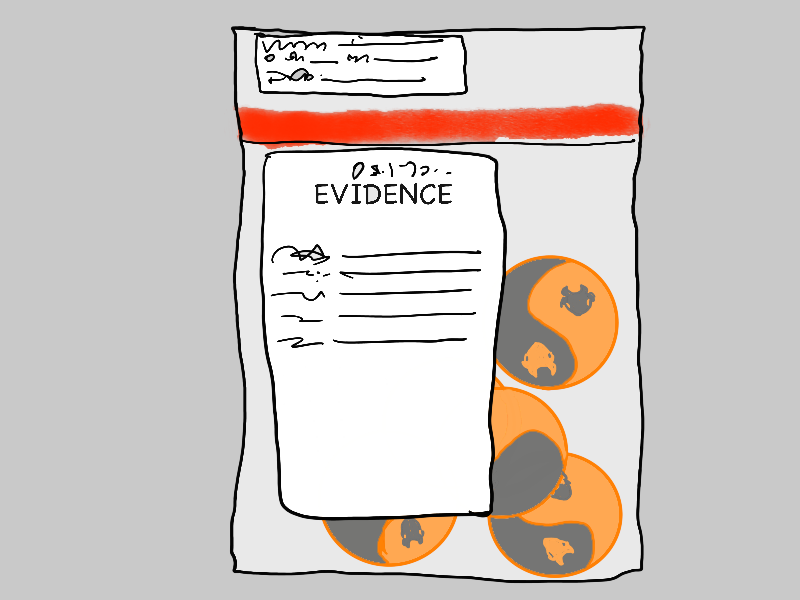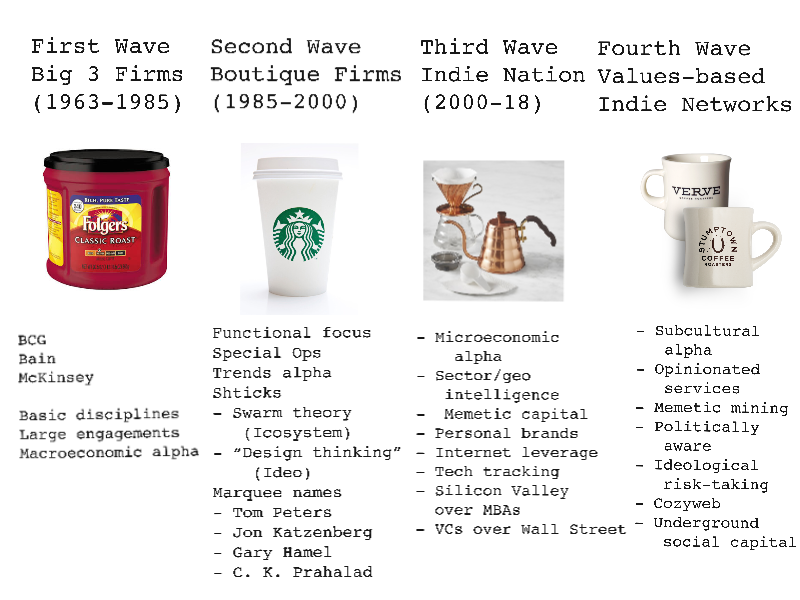Just over a year ago, in The Clutch Class (Aug 29, 2019), I argued that within the historical relationship between capital and labor, gigworkers would be considered scabs, and that this is a position we should unapologetically own:
The defining characteristic of a scab is striking a self-interested independent bargain with the capital-owning/managing/leading class that breaks from any larger collectively bargained deal…
So yes, to a 1910s union firebrand, we are no better than traitorous scabs.
This defining characteristic of scabs is also the defining feature of the gig-worker class. We defect from collective actions and trade off higher security, better benefits, and lower personal overheads, for two things…
More personalized working conditions built around desiderata that may not be shared by any larger group
Continuous, independent maneuvering capability where aligning interests with a group might require too much lock-step marching, or worse, voluntary social immobility
In that post, I proposed that we should consider ourselves a clutch class, as in both the mechanism and in the sports jargon sense.
In that post, I also took note of a piece of legislation that was at the time making its way through the California legislative process: AB 5, which sought to reclassify vast swathes of the gig economy as part of the paycheck economy, subject to minimum wage laws, benefits expectations, and crucially scheduled hours.
The bill, as you probably know if you follow these things, passed. But the battle did not end there. We’re now heading into another crucial battle: over Prop 22, which seeks to exempt rideshare companies from AB 5.
From AB 5 to Prop 22
AB 5 passed in 2019. I don’t have mixed feelings about this. It was a decisive step backwards from the brave new future of the gig economy. It was an utterly cynical and regressive piece of legislation that sought to manipulate sentiment against large corporations to deny access to flexwork to a large class of people, in order to secure traditional paycheck employment for a much smaller class.
Instead of solving the genuine new problems created by the new economic sector, it sought to transform the new problems into old ones that the political class knows how to profitably keep alive.
There is no great mystery as to why traditional labor politicians would push this kind of legislation: it is better to have 10 people beholden to you for a paycheck job than for 100 people to have the option to work in a flexible way without being politically beholden to any source of political patronage. This kind of calculus is the foundation of what is known as clientelism. It is a kind of politics that is nearly 200 years old. It is the kind of politics practiced by Donald Trump, except in the case of AB 5, it comes from the old-school Left.
Around this time last year, I recall watching a television interview with one of the politicians supporting the bill. She was saying something like “you shouldn’t have to work more than one full-time job to make a living.”
The statement was revealing. Those who support legislation like AB 5 believe in a one-person-one-job world. Because it is a world they know how to control politically.
This is not necessarily a bad-faith agenda. There are laudable political efforts that are primarily focused on workers making so little at a full-time job they have to either take a second job, or access safety net benefits, just to make ends meet. The best-faith reading of AB 5 is that it is in the spirit of other regulations designed to prevent exploitative employers from essentially externalizing part of their labor costs to the state, effectively turning the existence of a safety net into a business subsidy for themselves.
This problem is one that should be solved.
Minimum-wage laws, which work as temporary palliatives while automation drives matters towards a more permanent resolution, are a painful but acceptable distortion to the labor market that do exactly that (I’m in favor of minimum wage laws, but not for the usual humanitarian reasons).
AB 5 was not about solving that class of hidden-business-subsidy problems. It was about trying to grow the set of people who are vulnerable to that problem. It was about creating and capturing a new class of worker within traditional clientelistic labor power models. It was about preserving a world where “worker” is a legible category, and every individual has a single worker identity that can fit neatly into a single political representation, as a client beholden to a particular political patron.
Politics is like business that way: like Drucker said, it’s about creating a customer.
The idea of someone who works more than one job out of choice. Who is a small-scale, capitalist who owns at least a small piece of the means of production (a laptop, a car, a guitar), who wants to play with risk-and-return decisions, whether they involve record deals, viral blog posts, or pricing surges on rideshare, is deeply threatening to how traditional labor politicians build and exploit a base of political power.
After AB 5 passed, there was widespread general criticism from many corners of the gig economy. Gig musicians suddenly had to worry about being able to work at all. Many publishing outlets stopped accepting freelance writing from California-based writers.
But the response from one group in particular set the agenda for the larger fight: rideshare and delivery companies.
Rideshare companies won a temporary reprieve from the courts to avoid complying with AB 5, and sponsored a new ballot initiative, Prop 22, that will be voted on in November. Prop 22 basically seeks to exempt rideshare and delivery companies from AB 5. The rideshare and delivery companies (Lyft, Uber, Doordash, Instacart, Postmates) have poured over $180 million into the initiative, which is a record.
Here’s the thing. However distasteful it might feel to support big platform companies pouring this much money into a political process, in this case, they’re on the right side of history. (So if you’re a California voter and inclined to take cues from a scabby neoliberal shill like me: Yes on 22).
Not because they’re the good guys, but because the politics behind AB 5 is even worse.
California vs. Rideshare
It was never a secret that AB 5 was aimed directly at the rideshare companies, and if Prop 22 passes, AB 5 will basically be hollowed out into uselessness.
For Lyft, Uber, Instacart, and others in the business of turning people with cars into micro-capitalist free-agent franchisees, AB 5 was obviously an existential threat, and equally obviously, they could not possibly comply with the law and continue operating.
How much of an existential threat?
In a previous, lower-stakes version of the battle, in Austin, TX, the rideshare companies left the city rather than operate under a much less severe regulatory threat (fingerprinting regulations motivated by a rider safety case). In that case, I could see the logic of the regulatory attempt, and was sympathetic to it. In the year or so that it took for Lyft and Uber to return to the city under conditions they could live with, several small local startups emerged as alternatives (I’m not sure how many of them are still around).
As these things go, reclassifying contractors as employees is about a million times more threatening than being required to fingerprint drivers. It is a big enough threat that it is likely worth giving up even a huge and attractive market like California.
It is, of course, really hard to root for the rideshare and delivery companies. They are the face of Big, Evil, Platform Capitalism right now. But for years, it’s been equally obvious what’s actually a good way to rein in their excesses. Let’s call it the Actual Plan™ to clean up the dirty business of rideshare and delivery:
Actual Plan™
-
Clean up the shady capitalization that is distorting the prices of rides/deliveries
-
Compensate drivers for the value of the data they generate
-
Make the dispatching algorithms auditable and/or open source
-
Create room for drivers to differentiate and earn a premium
-
Give drivers a piece of the equity upside of the trend towards driverlessness
If we could do this, the price of rides/deliveries would likely go up, demand would go down somewhat, and the market will find its natural equilibrium. There would be fewer drivers, but they’d probably make more. But it wouldn’t be the sort of artificial restriction of supply that would be achieved by artificially forcing paycheck employment on a natural flexwork sector, or worse, something like the old taxicab medallion scheme.
There are of course, many problems faced by rideshare drivers as a consequence of being in the gig economy that are not the fault or problem of the platform corporations. The big one in the US of course, is of course health insurance, which (no brainer) should continue to be available through means that are not linked to employment, let alone traditional paycheck employment.
Obviously, the rideshare companies would fight the Actual Plan™ too, and if that battle took shape, I’d definitely be on the other side from them. Right now, there are no serious groups fighting for anything resembling the Actual Plan,™ but that doesn’t mean we should back the wrong plan because the right one isn’t being backed.
The Actual Plan™ aligns with the natural structure of the gig economy, represents the interests of all current drivers (not just the ones who want to level up to a paycheck job), and crucially, all potential drivers, for whom possibly driving rideshare is an option in reserve for when they need to patch over a rough time. It also turns the rideshare sector into a positive example of expanding the power and quality of the gig economy, rather than giving it a bad name and hanging it like a dog.
And this isn’t just a matter for people working in the rideshare or delivery businesses. Versions of these problems exist in all parts of the gig economy, and versions of the Actual Plan™ are already really in some parts. For example, on the high-end consulting front, where things are much better, we already “own the data” from our work to the extent that it’s intellectual property we generate (such as workshop materials or general business ideas) that does not rely on proprietary data client data.
There’s no reason that kind of power should not be enjoyed by drivers in the rideshare sector.
The Outlook
Patching over a rough time with gig economy income, incidentally, is what a lot of people are doing right now thanks to Covid19 (though more on the delivery end than the rideshare end). So this is a particularly fraught time for this issue to be coming to a head.
So what’s the outlook here?
I have no idea whether Prop 22 will pass or not, but the two futures that loom are clear: either it passes and rideshare/delivery companies stay in California, or it fails, and they leave rather than subject themselves to AB 5, throwing thousands of people out of work in the middle of a pandemic. The latter outcome is drastic enough that as in the case of the Austin exit, I imagine a return would be brokered around some sort of compromise.
Whatever the current structural problems of the sector, the basic idea of the sector itself is here to stay. We will not be giving up the convenience of ordering rides or food/grocery deliveries through apps. It is a genuinely technological advance over people using phones to call inefficient human-powered dispatching layers that are obviously better handled by algorithms.
The way the service is provisioned though, is much more fragile.
Regressive legislation like AB 5 could easily spread around the world, making the app-based service sector something like the regulatory-captured medallion-based cab sector it replaced.
Or, the current structure could continue, creating a large flexwork economy.
This doesn’t mean things will be perfect. These services are natural oligopolies for now. Until we invent a truly decentralized (eg. blockchain-based) way to provision them, and/or full autonomy arrives, there’s always going to be 2-3 branded service platforms offering rides and deliveries in every local market.
And of course, the serious capital-structure and price distortion problems of the industry will remain, and need to be gradually sorted out. Some now-familiar big names might go bankrupt, while this sorting out happens. But whatever the ultimate set of winners, it will likely still be oligopolist. Drivers will still be the relatively weaker party, even if they are not so weak that clientelistic political patronage is the right solution.
This means all the cronyist problems that come with oligopolies, the asymmetry in relations between the platforms and drivers, and the continuing struggle around the Actual Plan™ will continue for the forseeable future.
But like I said, that’s the worthwhile fight. The one worth fighting.
Unevenly Distributed Freedom
Though I think AB 5 is cynical political opportunism, there is a very real problem here. One traditional labor politicians are exploiting rather than actually solving.
The gig economy is creating a genuinely new class of worker-consumer-citizen with genuinely new kinds of representational needs, calling for a genuinely new kind of politician. Unfortunately, though it is big and growing, it is still too small to be worth cultivating. If you have political ambitions, trying to genuinely represent gig workers who want to be gig workers is not a smart career move.
Unlike most valuable political constituencies, we are not legible, concentrated, and easy to target and activate for political purposes. We also do not have a sufficiently cohesive and predictable set of political attitudes or interests. Our interests cannot be summarized in a single, simple political message that a politician could ride to power.
But this will not always be the case, and I hope savvy young political aspirants see that.
We free agents are not labor, but we’re not full-blown capitalists either. Owning a car (even debt-free) or laptop is nothing like owning a big share of a platform company. But the balance is swinging in our favor with every passing year.
We free agents are not pure producers, nor are we pure consumers. We are prosumers who “consume” work at our discretion, in a way that combines variety, risk-taking, and opportunism. An environment full of flexwork potential is critical for us. But at the same time, we do require some of the protections and safety nets that traditionally, labor movements have sought to win for their constituencies.
There are political representation needs here that are just close enough to old labor that we are vulnerable to capture by them if we don’t find our own political representatives.
One way to understand our economic and political condition, and why our interests keep running up against those of traditionally organized labor, is to consider the classic leftist slogan, “None of us is free until all of us are free.”
The slogan comes from Marxist theory, and can be roughly understood as the philosophical point (entirely valid) that patterns of structural oppression trap the oppressors as much as they to do the oppressed. That the freedom apparently enjoyed by the oppressor or capital-owning class is illusory, and that true freedom won’t exist until it exists for everybody, in the worker’s paradise to come. In practice, of course, the slogan serves to consolidate class solidarity within the traditional labor class, rather than underwrite any sort of universal philosophical debate about the psychology of oppression and the futures of all classes.
The pragmatic alternative to that slogan is the much less catchy, “Some of us are somewhat free, somewhat sooner than everybody else, and that’s probably a good thing up to a point for the universal cause of freedom.”
The future of freedom, with apologies to William Gibson, is unevenly distributed, and the scabby clutch class is creating it.
I am in the gig economy, I enjoy no employment based benefits like a minimum wage, paid sick leave, or unemployment/disability insurance. Yet I don’t feel oppressed. The freedom I enjoy feels very real, even if it is not perfect or complete or universally entangled with freedom for everybody.
Of course, as a well-paid management consultant, my situation is vastly different from those who rely on lower-valued work like driving or deliveries, but I’ve spent enough panicked months wondering how to get through lean patches, and deal with delayed invoices, with rent coming due, that I do in fact know what that’s like.
And cliched and Tom-Friedmanesque though the move may be, I’ve talked to enough rideshare drivers who clearly actually enjoyed their flexibility to know that this class is not a figment of my imagination.
The attempt, by traditional labor ideologues, to pretend that the freedom of the gig economy is some sort of false consciousness, or that everybody in it is really actually yearning for the security of a paycheck job and is being coerced by Evil Corporations to pretend otherwise, is gaslighting pure and simple.
So it is probably time for the gig economy to get real political representation, rather than expecting old labor to speak for us honestly. And I for one am happy to get behind any visionary young politicians with both the imagination and boldness to fight for the future rather than for the past.



